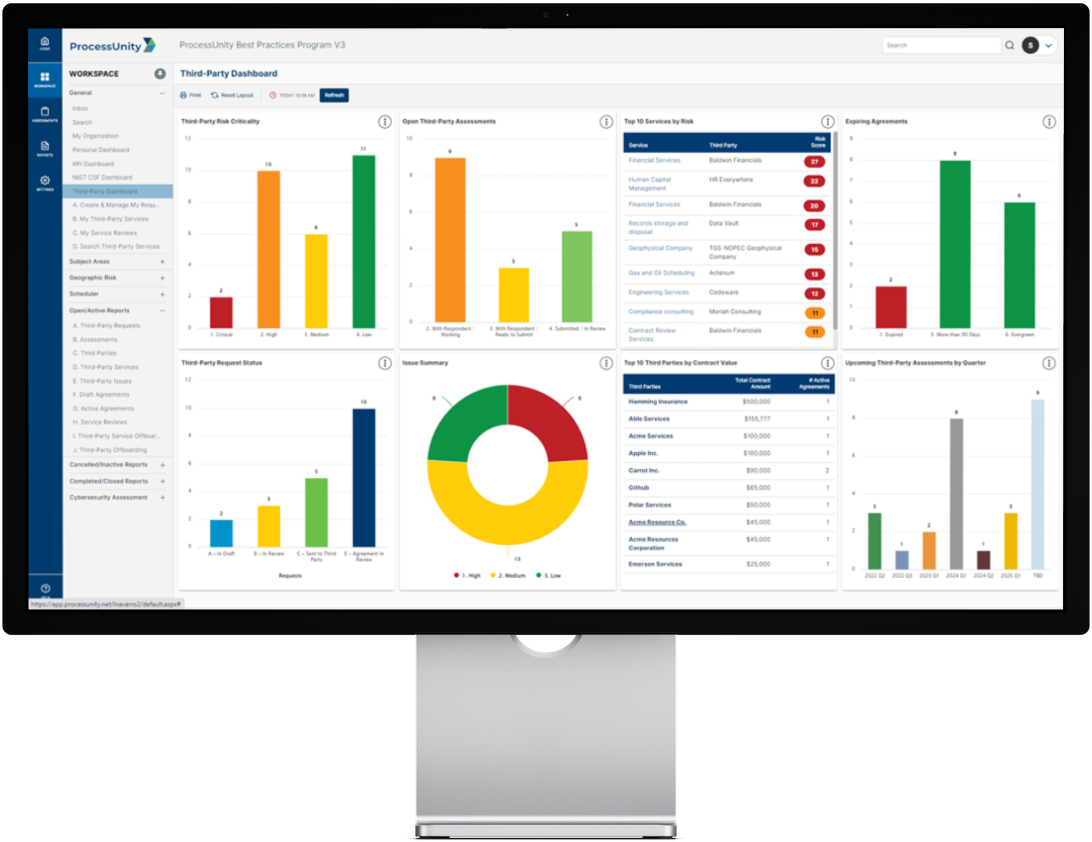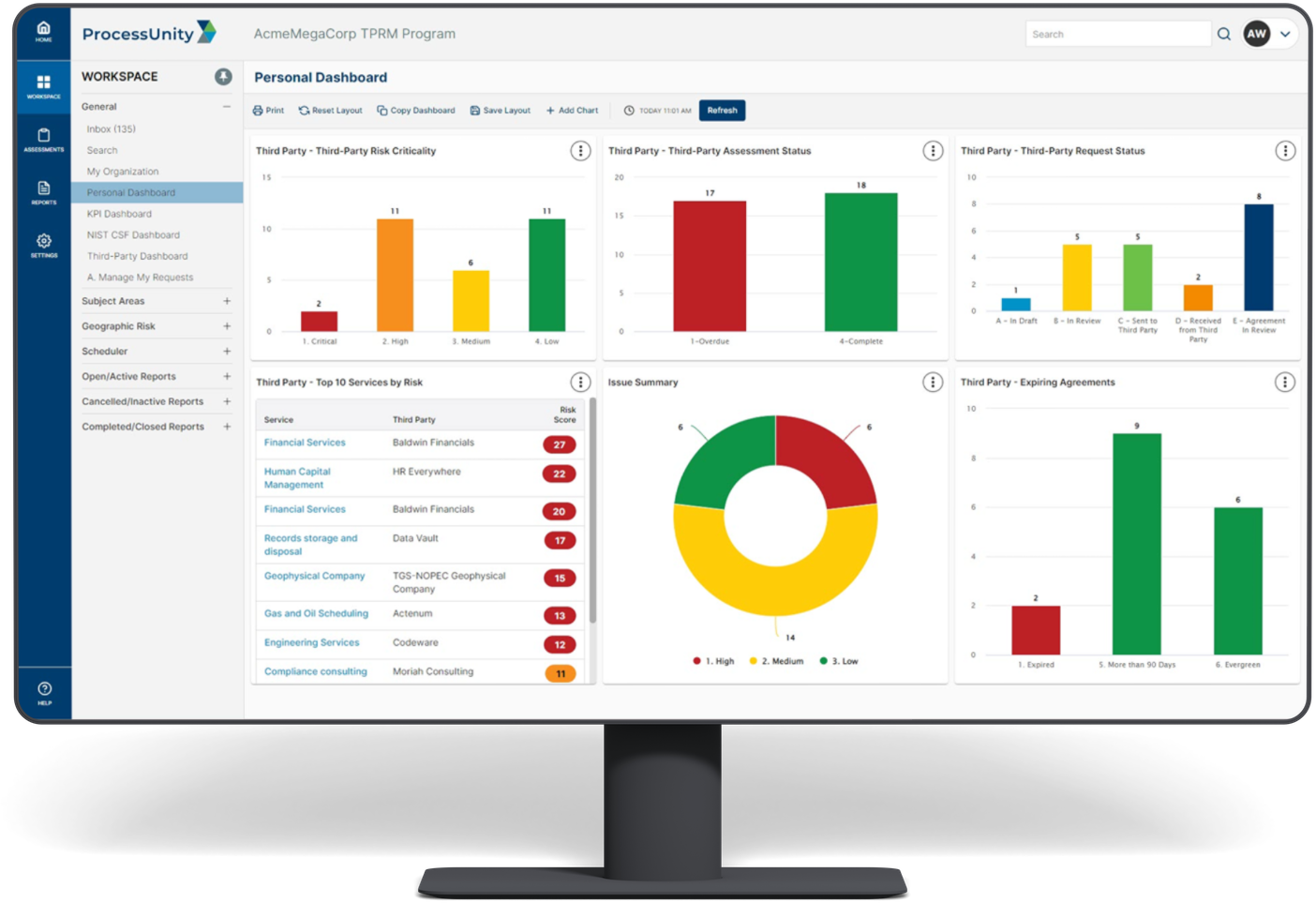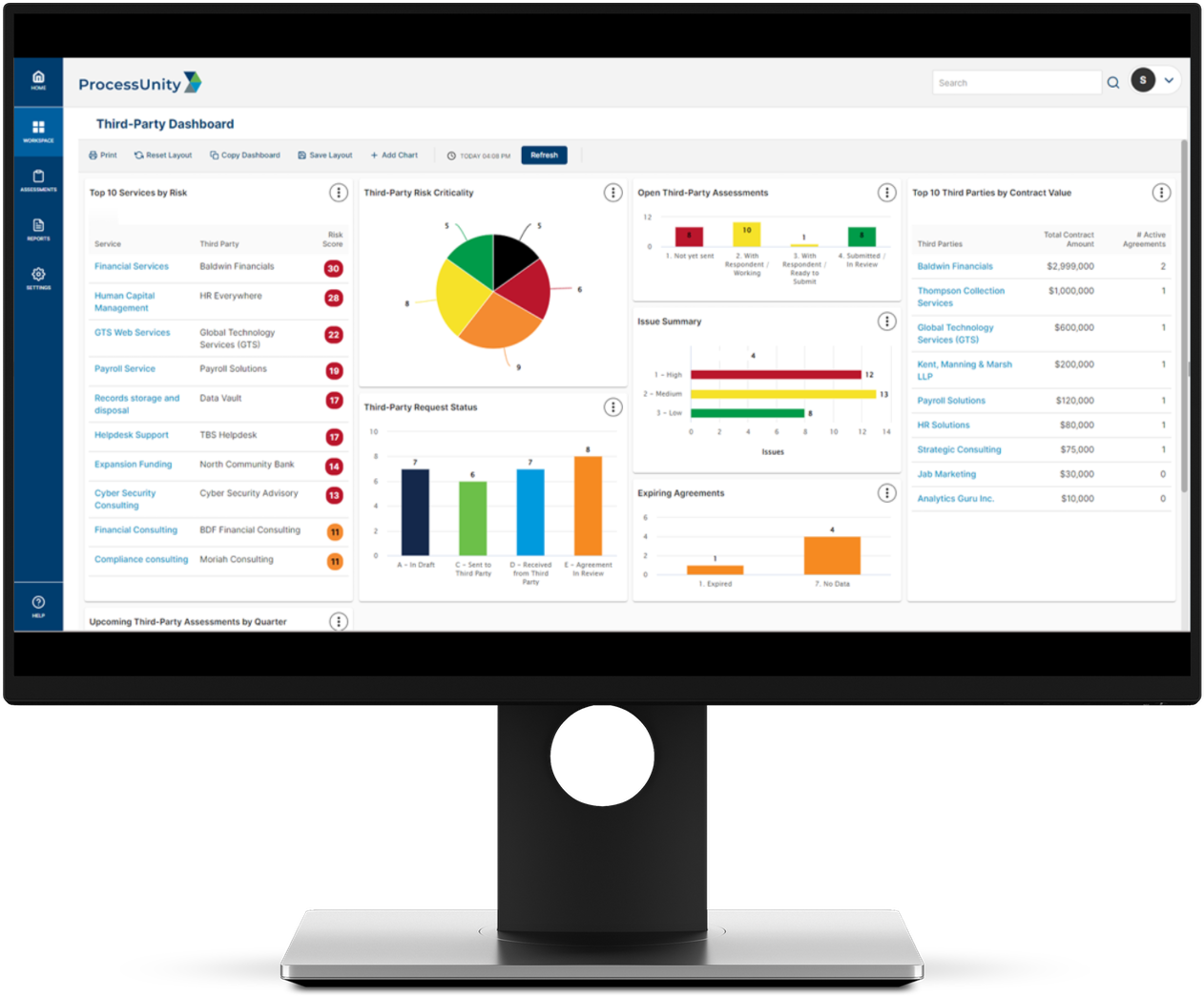Third-Party Risk Management Software
ProcessUnity: Software for End-to-End Third-Party Risk Management
In today's interconnected world of service providers, Third-Party Risk Management (TPRM) is more than a compliance necessity—it's a strategic imperative. At ProcessUnity, we understand the vulnerabilities that arise when TPRM demands outpace resources. We aim to overcome this challenge, helping organizations of all sizes and maturity levels close their TPRM vulnerability gap.

Workflow + Data + Exchange + AI
At ProcessUnity, we pride ourselves on our unique suite of features designed to elevate Third-Party Risk Management efficiency and effectiveness.
Our comprehensive TPRM workflow platform is the foundation, designed to streamline processes from vendor selection through offboarding, ensuring that risks are identified, assessed and mitigated in a systematic and coherent manner.
The Universal Data Core acts as a central repository which not only stores but also correlates data from diverse sources and systems. This allows for a more integrated risk assessment, taking into account the interconnected nature of third-party risk data.
Our Global Risk Exchange (formerly CyberGRX) is an expansive network of risk data and vendor assessments, curated by thousands of third parties worldwide and vetted by top audit firms. The insights and data consumed by our customers eliminates large portions of assessment work and allows teams to proactively monitor a larger portion of their vendor portfolios.
Lastly, AI-Powered TPRM Teams boost efficiency, consistency and accuracy, leveraging machine learning and natural language processing to automate routine tasks and identify risk patterns often overlooked by the human eye. This fusion of human expertise and advanced technology elevates your team’s performance, ultimately reducing more risk.
How We Help Various Stakeholders in TPRM
At ProcessUnity, we understand that effective TPRM involves multiple stakeholders, each with distinct needs and challenges. That’s why we’ve built solutions that address the unique requirements of each role.
- Third-Party Risk Executives: Our platform provides TPRM leaders with a comprehensive overview of third-party risks, enabling better decision making. Executives can quickly understand the risk exposure, track mitigation progress, demonstrate compliance and communicate with corporate leadership.
- Third-Party Risk Analysts: With ProcessUnity, TPRM analysts automate routine tasks, freeing up their time to focus on more complex risk assessments and strategic risk tasks. They are empowered to manage risks more efficiently, identifying concerns faster and addressing them before they become threats.
- Procurement Teams: Our tools help procurement teams to streamline vendor onboarding, ensuring that potential suppliers are vetted for risk before contracts are signed. They can also monitor existing vendors, ensuring continued compliance and performance.
- Information Security Teams: Our platform and tools help CISOs and their teams identify cybersecurity risks, leveraging vast amounts of third-party data to spot potential vulnerabilities and threats from both inside and outside the business. ProcessUnity reduces the burden of manual data analysis, ensuring no potential risk goes unnoticed.
- Risk/Compliance Professionals: We simplify the complex task of navigating regulatory requirements, providing tools that automate compliance processes, record actions for audit trials, and generate reports for regulatory submissions.
- Third Parties: Our dual-sided Global Risk Exchange removes the redundancy of one-off assessment requests. When third parties complete an assessment on the Exchange, they can instantly share it with multiple customers, saving staff time while effortlessly showcasing their compliance and risk management practices
In terms of industry coverage, ProcessUnity caters to a broad spectrum of industry sectors, including Energy & Utilities, Financial Services, Healthcare, Manufacturing, Pharma / Biotech / Life Sciences, Retail, Technology and a whole lot more. Each industry has unique TPRM challenges, and our solutions are tailored to address these specific needs while also considering the general principles of risk and compliance management.
Our Team’s Experience and Expertise
At ProcessUnity, our team of experts have a wealth of experience and knowledge relating to Third-Party Risk Management. This vast experience, coupled with our commitment to deliver value, is reflected in the proficiency of our services and the satisfaction of our customers. Our team’s expertise allows us to deploy our solutions swiftly, accelerating our customers’ time-to-value. We take pride in having the shortest deployment times in the industry. This rapid deployment does not compromise the quality or efficacy of our solutions, testament to the skill and efficiency of our team earned through more than 500 successful implementations worldwide.
Moreover, our successful track record is reflected in our customer satisfaction ratings and high renewal rates. Customers trust us with their evolving TPRM needs, a trust we attribute to our relentless pursuit of excellence and our commitment to customer success.
Close Your TPRM Vulnerability Gap with ProcessUnity
With ProcessUnity, you have a partner to help you close your TPRM vulnerability gap. Our proven technologies, coupled with our industry expertise, ensure you stay ahead of potential risks and secure in your business operations. Whether it’s eliminating inefficiencies, streamlining processes, or facilitating data-driven decision-making, our solutions are designed to maximize your risk management efforts and drive success. Take your first step towards a more protected future by choosing ProcessUnity, and together we’ll turn your TPRM challenges into opportunities for growth. Contact us today to get started.
Request a Demo: Third-Party Risk Management
Hundreds of organizations worldwide rely on ProcessUnity to make Third-Party Risk Management more effective and efficient. Schedule your personalized demo of our award-winning software and start your journey to a more mature, automated vendor risk management program today!
Request a Demo: Third-Party Risk Management



